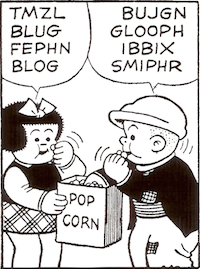I just learned that the following review (which I wrote in December 2003 and lost sight of) will not be printed in World Literature Today. No room. So here's a new home for it.
Joe LeSueur. Digressions on Some Poems by Frank O'Hara. New York. Farrar, Straus and Giroux. 2003. xxvii + 302 pages, ill. $25. ISBN 0-374-13980-6.
"I just met the most terrific person!": That is what Joe LeSueur remembers saying after meeting Frank O'Hara. LeSueur and O'Hara met in 1951; from 1955 to 1965 they shared a series of Manhattan apartments in what LeSueur calls an "ambiguous" relationship as roommates, friends, and occasional lovers. (It was the ambiguity that brought their life together to an end.) With Bill Berkson, LeSueur edited the invaluable assemblage of memoirs and essays Homage to Frank O'Hara (1988). In this book LeSueur (who died in 2001) assembles his memories and speculations concerning 40-odd Frank O'Hara poems.
LeSueur writes in response to poems that prompt memories; while a number of O'Hara's best-known poems are here, others ("Meditations in an Emergency" and "Why I Am Not a Painter," for two) are conspicuously absent. LeSueur does indeed digress, freely, wittily, and generously. He resists at almost every turn the impulse to provide critical commentary on poems: "I am not … so audacious as to delve into the singular depths of this poem" he writes of "Joe's Jacket" (named for his jacket, a seersucker from Brooks Brothers). Instead, he focuses on what Allen Ginsberg in his elegy for Frank O'Hara, "City Midnight Junk Strains," calls "deep gossip." A chapter on "Personal Poem" collects affectionate memories of artist Mike Kanemitsu before turning to less-friendly recollections of Amiri Baraka (then LeRoi Jones). A chapter on O'Hara's Jackson Pollock poem, "Digression on Number 1, 1948," turns into an unflattering portrait of Pollock's wife Lee Krasner. At times deep gossip threatens to make O'Hara's poetry peripheral, most dismayingly when LeSueur tries to find a "personal response" to the dense, dazzling "In Memory of My Feelings." He finds that the poem triggers "nothing" and proceeds to recount painter Grace Hartigan's gaucheries. (The poem is dedicated to Hartigan.) Here and elsewhere LeSueur seems to be settling scores, and the relation between commentary and poem becomes reminiscent of Nabokov's Pale Fire (a resemblance LeSueur no doubt consciously makes use of).
A claim that one is unable to "analyze" ("Make of it what you will" is one recurring phrase; "What can I say?" is another) might seem merely a pose--LeSueur did, after all, major in English. But I think that LeSueur's claim is genuine: he is without the luxury of critical distance. And unlike Nabokov's Charles Kinbote, LeSueur shared a world with the poet of whom he writes, making Digressions on Some Poems by Frank O'Hara a uniquely valuable adjunct to O'Hara's poems. LeSueur offers countless details of New York at mid-century: the jobs available to a young man with a "worthless" liberal arts degree, the pieces one would hear on classical radio stations, the various subcultures of gay Manhattan. LeSueur offers a fascinating commentary on O'Hara's use of blond and blonde and identifies numerous film references in the poems. His digressions bring relatively neglected poems--"John Button Birthday," for instance--into view. And he recounts events for which there are few if any other surviving witnesses, including the aftermath of the famous "4:19 to East Hampton" train that O'Hara has on his mind in "The Day Lady Died." As the details of Frank O'Hara's world--rotary phones, unfiltered cigarettes, old movies on late-night television--recede further from view, Digressions on Some Poems by Frank O'Hara honors O'Hara's poems by providing contexts for their further appreciation.


